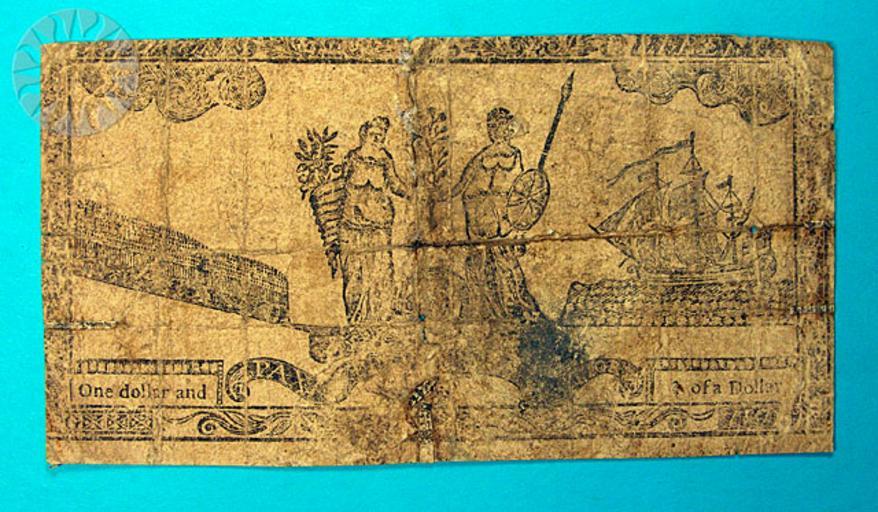MAKE A MEME
View Large Image

| View Original: | Maryland,_1_2/3_Dollars,_1775.jpg (640x373) | |||
| Download: | Original | Medium | Small | Thumb |
| Courtesy of: | www.flickr.com | More Like This | ||
| Keywords: legendary coins legendarycoins numismatics money smithsonian probably public domain probablypublicdomain SI Neg. 2005-27395. Date: 9/1/2005...American currency was sometimes used to mold public opinion during the War for Independence. The high-minded Latin mottoes suggested by Ben Franklin had this intent. So did a series of small, printed messages on North Carolina currency issued between 1778 and 1780. But an early series of Maryland notes, including this specimen, stand out. .The note is worn, and, in common with several of its fellows, it was carefully stitched together, obscuring part of the design. But if we could see everything, we would see that, on the front of the note, a figure representing Great Britain receives a petition of the Continental Congress. It is handed to her by an America, who is simultaneously trampling on a scroll marked SLAVERY and holding aloft a Liberty cap on a pole, a beacon for American troops who are hastening to the scene from the right. .Meanwhile, George III (the figure at the center-left) is doing his best to set fire to an American city (perhaps Baltimore) already under attack from a British fleet. He's also trampling a copy of Magna Charta, just to underscore the point. Inscriptions along the sides read "AN APPEAL TO HEAVEN" and "PRO ARIS ET FOCIS" (For altars and hearths). The other side of the note conveys hope. Britain and America are shown achieving peace, with the reminder that "PAX TRIUMPHIS POTIOR" (Peace is preferable to victory)..The note was designed by Annapolis silversmith Thomas Sparrow in the summer of 1775. His initials are inscribed on the front and his full name on the back. This series of Maryland notes remains the most politically charged currency ever issued in the United States during wartime..Click here to view the reverse...Credit: Tom Mulvaney (Smithsonian Institution) SI Neg. 2005-27395. Date: 9/1/2005...American currency was sometimes used to mold public opinion during the War for Independence. The high-minded Latin mottoes suggested by Ben Franklin had this intent. So did a series of small, printed messages on North Carolina currency issued between 1778 and 1780. But an early series of Maryland notes, including this specimen, stand out. .The note is worn, and, in common with several of its fellows, it was carefully stitched together, obscuring part of the design. But if we could see everything, we would see that, on the front of the note, a figure representing Great Britain receives a petition of the Continental Congress. It is handed to her by an America, who is simultaneously trampling on a scroll marked SLAVERY and holding aloft a Liberty cap on a pole, a beacon for American troops who are hastening to the scene from the right. .Meanwhile, George III (the figure at the center-left) is doing his best to set fire to an American city (perhaps Baltimore) already under attack from a British fleet. He's also trampling a copy of Magna Charta, just to underscore the point. Inscriptions along the sides read "AN APPEAL TO HEAVEN" and "PRO ARIS ET FOCIS" (For altars and hearths). The other side of the note conveys hope. Britain and America are shown achieving peace, with the reminder that "PAX TRIUMPHIS POTIOR" (Peace is preferable to victory)..The note was designed by Annapolis silversmith Thomas Sparrow in the summer of 1775. His initials are inscribed on the front and his full name on the back. This series of Maryland notes remains the most politically charged currency ever issued in the United States during wartime..Click here to view the reverse...Credit: Tom Mulvaney (Smithsonian Institution) | ||||